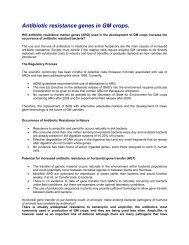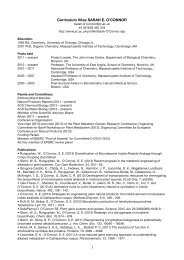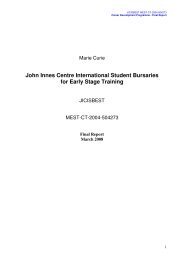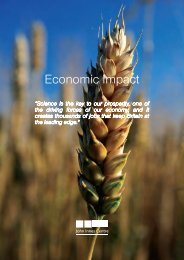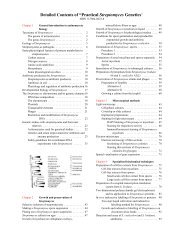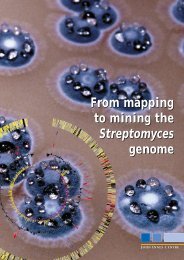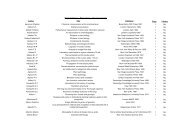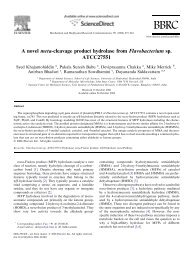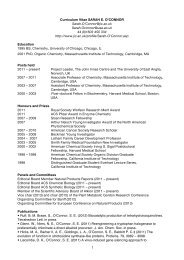1910s Timeline - John Innes Centre
1910s Timeline - John Innes Centre
1910s Timeline - John Innes Centre
Create successful ePaper yourself
Turn your PDF publications into a flip-book with our unique Google optimized e-Paper software.
1941 Advisory work takes off<br />
As a result of the publication of<br />
leaflets (10,000 distributed by<br />
1941) and of broadcasts by M. B.<br />
Crane and W. J. C. Lawrence,<br />
the advisory work of the JIHI<br />
multiplies several times over.<br />
Between 1939 and 1942 the<br />
Pomology Department receives<br />
over five thousand public<br />
enquiries. This work has brought<br />
JIHI into a closer relationship<br />
with horticulturalists in the<br />
practical and educational<br />
sphere. It has also led to the<br />
adoption of JIHI’s improved<br />
methods of raising garden<br />
crops. In mid-1941 JIHI<br />
estimates that in England 40%<br />
of the larger commercial<br />
growers and 17% of the smaller<br />
ones have adopted the use of<br />
<strong>John</strong> <strong>Innes</strong> composts. The<br />
advance has been less rapid in<br />
Scotland. During the 1940s<br />
there are many requests for<br />
talks on the JI composts and on<br />
the new methods of cultivation<br />
under glass.<br />
In 1943-44 the first instructional<br />
film is taken at <strong>John</strong> <strong>Innes</strong>, a<br />
colour cinema film to illustrate<br />
<strong>John</strong> <strong>Innes</strong> Leaflet no. 4, ‘The<br />
fertility rules in fruit planting’<br />
(30,000 copies of this leaflet<br />
have been distributed since its<br />
publication in 1941). The first<br />
sequences shot include pollen<br />
development, fertilization, and<br />
fruit formation. The film is<br />
aimed at fruit farmers and<br />
teachers.<br />
1941 One gene, one enzyme<br />
At California Institute of<br />
Technology, USA, George<br />
Beadle and Edward Tatum’s<br />
experiments on the red bread<br />
mould Neurospora crassa show<br />
that the function of genes is to<br />
direct the formation of enzymes<br />
which regulate chemical events.<br />
They propose that in general<br />
each gene directs the formation<br />
of one (and only one) enzyme –<br />
affirming the ‘one gene, one<br />
enzyme’ hypothesis. This<br />
hypothesis, which Hickman and<br />
Cairns (2003) argue began with<br />
French biologist Lucien Cuénot<br />
in 1903, is usually attributed to<br />
Archibald Garrod and his<br />
pioneering work on ‘inborn<br />
errors of metabolism’ (1908).<br />
William Bateson also suggested<br />
in 1909 that certain Mendelian<br />
traits were due to the presence<br />
or absence of an enzyme.<br />
For further information on<br />
Beadle and Tatum’s<br />
experiments:<br />
http://www.genome.gov/2552<br />
0248<br />
http://www.genetics.org/cgi/c<br />
ontent/full/166/1/1<br />
For a discussion of Archibald<br />
Garrod’s seminal lecture series<br />
(1908):<br />
http://www.encyclopedia.com/<br />
doc/1P3-1487595401.html<br />
For a discussion of the history of<br />
the ‘one gene, one enzyme’<br />
concept:<br />
http://www.genetics.org/cgi/c<br />
ontent/full/163/3/839<br />
1942 Kenneth Mather and the<br />
Russian controversy<br />
In 1942 Mather publishes a<br />
critique of the Russian<br />
government’s opposition to<br />
genetics in Nature. Unlike many<br />
fellow geneticists he does not<br />
emphasize the unscientific<br />
nature of plant science in Russia<br />
under the leadership of Trofim<br />
Lysenko but gives a measured<br />
appraisal of the development of<br />
genetics over 40 years. He<br />
acknowledges that genetics has<br />
neglected aspects that are of<br />
importance to the breeder (that<br />
is, the study of quantitative<br />
characters) and has<br />
consequently disappointed<br />
those looking for a practical<br />
return. Affirming his<br />
commitment to the study of<br />
Page 36 of 91



